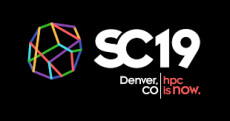SENSE Takes Software-Defined Networking to the Next Level
November 11, 2019
As part of SC19’s Network Research Exhibition, ESnet will help demonstrate advancements in networked system automation as part of the Software-defined network for End-to-end Networked Science at Exascale (SENSE) project.
In the era of big data driven by exascale computing, cloud computing, machine learning, and artificial intelligence, the SENSE team is building intelligent network services. This system allows scientific applications to manage and schedule network resources in a manner similar to experimental instruments and computing and data storage resources.
SENSE enables the provisioning of multi-domain, multi-resource end-to-end Layer 2 and 3 services including end-site resources such as data transfer nodes (DTN), which are servers in a data center that are optimized for bandwidth and tuned to transfer data efficiently. The SENSE Layer 2 services include deterministic end-to-end resource guarantees and automated DTN private address configuration. The SENSE Layer 3 service provides mechanisms for directing traffic onto a specific Layer 3 Virtual Private Network for policy or quality of service reasons. The system also allows workflow middleware to redirect traffic at granularities of a single flow, a specific end-system, or an entire end-site onto a SENSE provisioned service.

The SENSE demonstration at SC19 will be held in the Caltech booth, #543.
The SENSE team is led by ESnet and includes participants from Fermilab and Argonne National Lab and the National Energy Research Scientific Computing Center at Berkeley Lab, and Caltech and the University of Maryland/Mid-Atlantic Crossroads. The SENSE demonstration at SC19 utilizes a persistent testbed which has been deployed across these participant facilities and adds resources on the exhibit showroom. The SENSE NRE demo is identified as "SC19-NRE-013 – SENSE: Intelligent Network Services for Science Workflows" and will be held in the Caltech booth, #543.
At SC19, the team will demonstrate the new SENSE Layer 3 service and the ability to integrate with domain science workflows and other cyberinfrastructure systems, by interacting with the production provisioning system of ESnet and other regional and site networks. This will include early work and vision for integration of SENSE with the Large Hadron Collider File Transfer Services, DOE Superfacility, BigData Express, and the AutoGOLE – a global scale network-provisioning system using open standards.
The SENSE team is also collaborating with other NRE demonstrations, including the following:
- SC19-NRE-019 - Global Petascale to Exascale Workflows for Data Intensive Science
- SC19-NRE-020 - LHC Multi-Resource, Multi-Domain Orchestration via AutoGOLE, SENSE
- SC19-NRE-011 - BigData Express: A scalable and high-performance data transfer platform
- SC19-NRE-023 - International Data Transfer over AmLight Express and Protect (ExP)
About Computing Sciences at Berkeley Lab
High performance computing plays a critical role in scientific discovery. Researchers increasingly rely on advances in computer science, mathematics, computational science, data science, and large-scale computing and networking to increase our understanding of ourselves, our planet, and our universe. Berkeley Lab’s Computing Sciences Area researches, develops, and deploys new foundations, tools, and technologies to meet these needs and to advance research across a broad range of scientific disciplines.







 Instagram
Instagram YouTube
YouTube